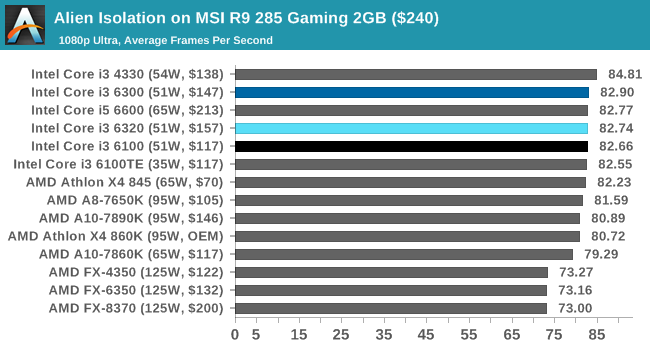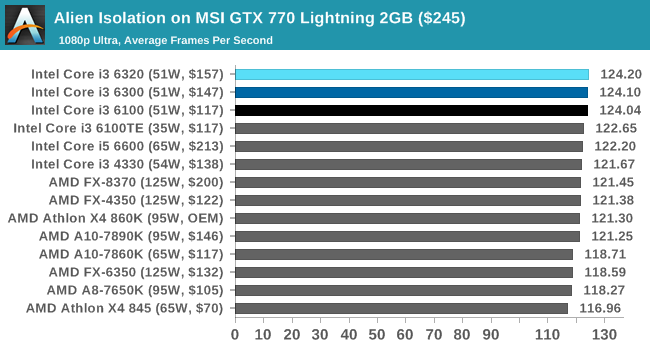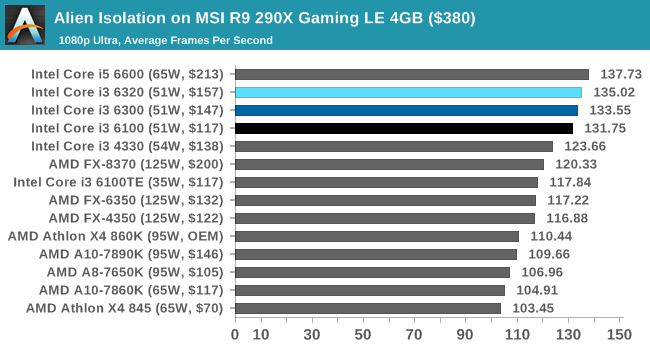The Skylake Core i3 (51W) CPU Review: i3-6320, i3-6300 and i3-6100 Tested
by Ian Cutress on August 8, 2016 9:00 AM ESTAlien: Isolation
If first person survival mixed with horror is your sort of thing, then Alien: Isolation, based off of the Alien franchise, should be an interesting title. Developed by The Creative Assembly and released in October 2014, Alien: Isolation has won numerous awards from Game Of The Year to several top 10s/25s and Best Horror titles, ratcheting up over a million sales by February 2015. Alien: Isolation uses a custom built engine which includes dynamic sound effects and should be fully multi-core enabled. We take the average frame rate as our marker with a scripted version of the built-in benchmark.
For this test we used the following settings with our graphics cards:
| Alien Isolation Settings | |||
| Resolution | Quality | ||
| Low GPU | Integrated Graphics | 1280x720 | Ultra |
| ASUS R7 240 1GB DDR3 | |||
| Medium GPU | MSI GTX 770 Lightning 2GB | 1920x1080 | Ultra |
| MSI R9 285 Gaming 2G | |||
| High GPU | ASUS GTX 980 Strix 4GB | 1920x1080 | Ultra |
| MSI R9 290X Gaming 4G | |||
Alien Isolation seems to have recently had an update that affects low powered GPUs, pushing our new results to be very different to the results in our database. It only seems to affect the IGP and R7 240 results, so for now we'll focus on the other data.




In each case the Core i3s perform at the top or near the top, with the higher frame rates being with the higher frequency parts. However, for our mid-range GPUs (R9 285, GTX 770), that doesn't seem to matter that much, and the $70 AMD Athlon X4 845, along with the A10 parts, are within shouting distance. However, the effect gets worse with higher power GPUs, with the graphs taking an Intel/AMD split almost. The 8-thread AMD FX part sits as close as it can, but the Skylake parts pull a 10+ FPS advantage, which equates to an 8% or better difference.











94 Comments
View All Comments
Andr3w - Friday, September 16, 2016 - link
Hello guys ! I currently own a 860k OC at 4.2 Ghz paired with a Sapphire R7 370 2gb . After consulting this review I understand that the i3-6100 paired with the same R7 370 will perform better in gaming ? Correct me if I am wrong !Note : Currently I think, the 860k bottlenecks my R7 370 in Tom Clancy The Division. I am sayng this becasue the readings from MSI Afterburner show the following stats at medium settings, 1920x1080 resolution, V-Sync off :
GPU Usage 65 - 70 % with 1800 VRAM usage
CPU Usage on all 4 cores : 98 - 100 %
On the other hand in Star Wars Battlefront, on high settings, 1920x1080 resolution, V-Sync off, I've read the following stats :
GPU Usage : 100 % with about 1700 VRAM usage
CPU Usage : 65-70 % on all 4 cores.
So will it worth changing to i3-6100 ?
KosOR - Tuesday, October 30, 2018 - link
Recently, I had an opportunity to purchase cheaper new Haswell or Skylake motherboard together with cheaper second hand i3 processor. And I searched and found this article comparing i3-6100 and i3-4330 processors. I also compared both CPUs at PassMark and UserBenchmark results (cpubenchmark.net, userbenchmark.com). The cumulative performance difference there was not greater than 15%. The 15% number seems also compatible with CPU architecture improvement and slightly higher clock speeds. That's why I was very surprised to see much higher performance difference in this article for almost all real world tests (Dolphin Benchmark, 3D Particle Movement v2, Mozilla Kraken and Google Octane v2). Personally, I could not find any logical reasons explaining those elevated performance numbers of Skylake i3 CPUs. Can anybody explain me why we see such big (greater than 30%) real world performance differences in all of those tests?KosOR - Tuesday, October 30, 2018 - link
Those higher than 15% performance numbers are also observable in 2 other test results - HandBrake v0.9.9 2x4K and Hybrid x265. Can anybody find the explanation in any of the architecture improvements from Haswell to Skylake generation of CPUs?KosOR - Tuesday, October 30, 2018 - link
Yet another absurd result is of Pentium G3420, which wins over i3 4330 on Dolphin benchmark by more than 15%. It looks absurd that 2 thread, 3.2GHz, 3 MB cache Haswell processor achieves 15% better result over 4 thread, 3.5GHz, 4 MB cache Haswell processor. Such results make me feel suspicious of all other test results on the charts, sorry.